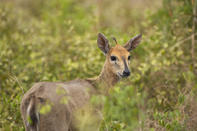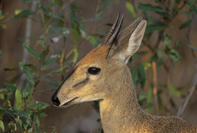Hair Tuft
The common duiker has a host of common names including common, grey and Grimm’s duiker. The name ‘duiker’ is derived from the Afrikaans word ‘duik’ meaning ‘to dive’ due to its characteristic porpoising flight pattern.

Common duiker are identifiable by their slate grey colour, which in some areas varies to include shades of red and yellow. They have a tuft of dark hair between the horns, or just on the head in the case of the females as horns are absent, and a dark stripe down the centre of the face.
The preorbital glands, in front of the eyes, are conspicuous and exude a tarry secretion probably used in scent marking.
They tend to live in areas with lots of bushy cover, unlike steenbok who prefer open areas. It is into this cover that they dart and dive when disturbed. They have excellent hearing, which alerts them to disturbances.
Odd Diet
Common duiker are known to consume unusual food substances for antelope. There are several records of them eating nestling ground birds as well as records of reptiles, mopane worms and even a mouse in their diet.
It is unknown whether these items were consumed accidentally during browsing or whether duiker purposely consume these items as protein supplements.
Aside from the usual browse material that they eat, duiker dig for tubers and nibble bark off trees and shrubs.
Duiker are solitary in nature except when a female is in oestrus at which time she may be attended by a male. Babies are exceptionally precocial and within 24 hours they can run around energetically. They mature very rapidly obtaining adult size by only six or seven months old.
Quick Facts

50 cm shoulder
Weight
Male: 15 - 18 kg
Female: 16 - 21 kg
Lifespan
11 years
Habitat
Savanna with bushy cover – home range 21 ha
Gestation
7 months
Number of young
1
Food
Browsers – leaves, twigs, fruit, flowers, seeds, forbs
Predators
Medium to large carnivore, martial eagle
By Megan Emmett